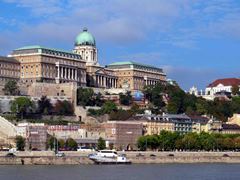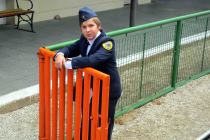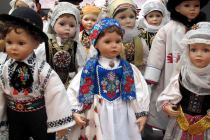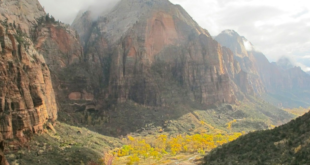We've just come back from a fascinating journey to four East European cities: Budapest, Sibiu, Brasov, and Prague. Our journey began in Budapest.
Budapest by Foot
We stayed in an apartment called The Blue Danube Flat. It was in an atmospheric old building with an internal courtyard, just off the touristy street of Vaci, a place to look rather than buy and eat. Only a few streets away there were much cheaper restaurants where we ate huge Hungarian dinners for $15 – $20, including a glass of beer or mineral water.
Budapest was a great walking city. Half of the city is flat (Pest) while on the other side of the Danube it is hilly (Buda).Much of our time was spent meandering through the old cobbled streets, admiring the Art Nouveau buildings, the Jewish quarter, the huge Catholic basilica and the old castle district.

Budapest Markets
It was an easy walk from our apartment to the river and to Budapest's oldest and largest market: the Great Market Hall. There was a huge variety of cheeses, salamis, fruit and bread to choose from. Chillies in many different varieties added splashes of colour and were strung and hung above the stalls.
The stall holders had very little English so we didn't always know what we were buying for lunch – a large hunk of what I thought was cheese turned out to be freshly churned butter.
There are lots of markets to explore in Budapest. We headed into the city in search of WAMP, a famous designer market with one-off pieces of jewellery and designer clothes. On the way we discovered a much more affordable outdoor market, the perfect place to buy quality handmade gifts and to sample some local chutneys and jams. We couldn't resist indulging in the local speciality: langos – deep fried bread served covered in sour cream and cheese. As if this wasn't enough we stopped at a little Hungarian café later for lunch for a chilled sour cherry soup, which was really delicious.
The Arts
Budapest is a great place for art lovers. One afternoon we met up with Barbara, an art student who had home-stayed with friends of ours while she was an exchange student in New Zealand. She took us to a brilliant exhibition in the elegant National Gallery located in Buda castle. Works by Chagall were partnered with paintings by Imre Amos, a Hungarian painter. Sadly Imre Amos, who was Jewish, died at a comparatively young age in a concentration camp.
Music is a big part of the cultural life of the city. We were lucky to find a concert close to our apartment which was part of a Budapest baroque festival – two young musicians on flute and harpsichord in St Michael's church.
The Children's Railway
Foodie friends of ours had told us that the Children's railway was not only a charming and unique excursion but at the top they had sampled the best piece of cherry strudel they had ever tasted.
So we took a trip into the Buda hills on a cog railway and then onto a ride on the children's railway which runs through a hilly forested area in Buda.
 Apart from the driver, who is an adult, the railway is entirely staffed by children who looked the part in proper uniforms and did their best to be really professional. It's a unique way of teaching children to take responsibility and learn teamwork. It is also one of the few traditions the Hungarians have kept from the Communist era.
Apart from the driver, who is an adult, the railway is entirely staffed by children who looked the part in proper uniforms and did their best to be really professional. It's a unique way of teaching children to take responsibility and learn teamwork. It is also one of the few traditions the Hungarians have kept from the Communist era.
Unfortunately, the restaurant selling the cherry strudel was closed until the weekend but no matter, we'd really enjoyed the experience.
Szentendre
On our last day in Budapest we travelled the short distance to Szentendre, a historic small town on the Danube about 25 km away. Szentendre is a beautiful touristy town, with old churches, cobbled streets and the river, a nice place to relax. And as the sky was blue, so was the Danube that day.
Sibiu in One Day
We left Budapest by train, taking a 10 hour trip to Sibiu in Romania, travelling first class on plush red upholstered seats. We'd packed a picnic: bread, salami, cheese salad ingredients and fruits and some chocolate as well as a bottle of wine. For most of the journey we were the only passengers in the whole carriage so we had room to spread out.
We traversed the great Hungarian plain interspersed with some forested areas where the trees were tinged with autumn colours. Many of the fields were lying fallow. Here and there were pockets of sunflowers. We passed small villages with dirt paths.
Our Sibiu hotel, Levoslav House, was in an old 18th Century building in the old historic centre. We had only one day there to walk around the old parts of the town (a Unesco World Heritage site), starting at the Grand Square with its mixture of different architectural styles: Baroque, Art Nouveau and Renaissance.
From there we climbed up and down many steps and along narrow picturesque streets to admire the old houses.
The City Walls
 Sibiu still has parts of the original walls around its centre, the most famous of which is the old 13th century tower the Turnul Sfatului in the main square. John posed by the western wall in front of the Potters' tower. His family didn't actually get here in the 14th century, but during times of battle the artisan potters were expected to defend the town from this tower. There are similar Archers' and Carpenters' towers still standing.
Sibiu still has parts of the original walls around its centre, the most famous of which is the old 13th century tower the Turnul Sfatului in the main square. John posed by the western wall in front of the Potters' tower. His family didn't actually get here in the 14th century, but during times of battle the artisan potters were expected to defend the town from this tower. There are similar Archers' and Carpenters' towers still standing.
We were in Sibiu on a Monday so unfortunately all the museums and galleries were closed except for a historical museum attached to a Lutheran church. Here we had a lesson in what had at times been a tempestuous church history. All the exhibits were subtitled in three languages (including English) which made it easy to follow. A highlight was the large collection of dolls dressed in a variety of folk costumes.
Our time in Sibiu was all too brief. In the late afternoon we left for Brasov, another 2 ½ hour train journey.









Join the Discussion
Type out your comment here:
You must be logged in to post a comment.